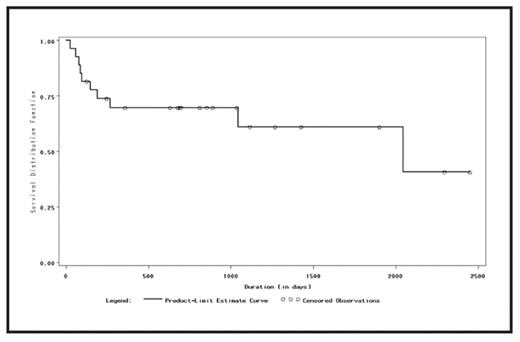Abstract
Myeloproliferative disorders (MPD) are characterized by marrow clonal proliferation leading to ineffective hematopoiesis. Between 1998 and 2007, 27 patients (pts) with myeloproliferative disorders were treated with hematopoietic stem cell transplantation. Patients included 9 males (33%) and 18 females (67%) with a median age of 52 years (range 30–68). Diseases included Philadelphia chromosome-negative chronic myelogenous leukemia (CML) (n=2, 7%), myelofibrosis (n=21, 78%), polycythemia vera (n=2, 7%) and essential thrombocythemia (n=2, 7%). Twelve patients (44%) had abnormal cytogenetics, 24 pts (89%) had splenomegaly and 9 pts (33%) had a prior splenectomy. Preparative regimens included busulfan and cyclophosphamide (n=11, 41%), cyclophosphamide and total body irradiation (n=3, 11%), fludarabine and busulfan (n=3, 11%), fludarabine and cyclophosphamide (n=1, 4%), fludarabine and melphalan (n=7, 26%), and fludarabine with low dose total body irradiation (n=2, 7%). Patients with unrelated donors also received ATG. Twelve patients received an unrelated donor product, 7 pts received bone marrow and 20 pts received peripheral blood stem cells.
The 5-year overall Kaplan-Meier product-limit survival estimates (figure 1.) was 60.9%. The day 100 transplant-related mortality was 18.5%, all in patients receiving either cyclophosphamide and total body irradiation or cyclophosphamide and busulfan. Overall, there were twice as many deaths in patients receiving a non-fludarabine-based regimen (n=7, 25.9%) compared with patients receiving a fludarabine-based regimen (n=3, 11.1%) though the difference was not statistically significant (p=0.15). The overall incidence of grade II–IV acute GVHD was 44% and chronic GVHD was 64%. The overall relapse rate was 16%. No significant differences in relapse rates by acute (p=0.40) and chronic GVHD (p=0.53) or by fludarabive vs non-fludarabine based regimens (p=0.24) were observed. In univariate Cox proportional hazard models, chronic GVHD was the only significant factor associated with worse survival (p=0.035).
In conclusion, myeloproliferative disorders can be successfully treated with allogeneic hematopoietic stem cell transplantation. Chronic GVHD significantly reduces overall survival. The optimal preparative regimen still remains to be determined.
Kaplan-Meier product-limit survival estimates of MPD treated with allogeneic hepatopoietic stem cell transplantation (n=27).
Kaplan-Meier product-limit survival estimates of MPD treated with allogeneic hepatopoietic stem cell transplantation (n=27).
Disclosures: No relevant conflicts of interest to declare.
Author notes
Corresponding author


This feature is available to Subscribers Only
Sign In or Create an Account Close Modal